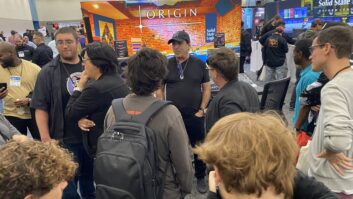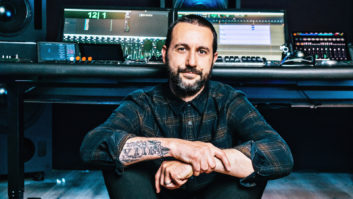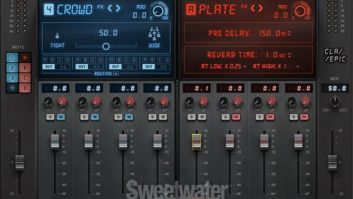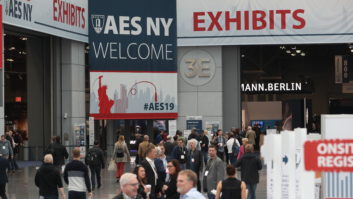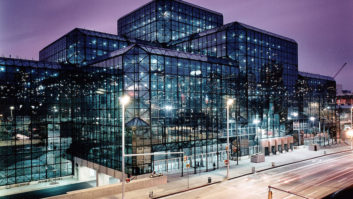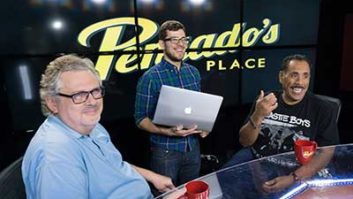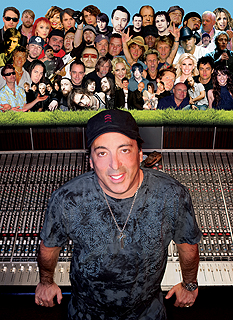
Sgt. Lord Alge’s All-Star Band: This collage represents a selection of the engineer’s credits.
Photos: Meeno Peluce
Does Chris Lord Alge really need an introduction at this point? From Green Day, Stone Temple Pilots, Hole, Nickelback and My Chemical Romance, to Faith Hill, Bon Jovi, Melissa Etheridge and countless more, Lord Alge has had a long run of mixing hits. He’s smart, funny, outspoken and has a unique way with words. He likes to keep the energy up, and he’s legendary for the speed at which he mixes. He’s extremely efficient, but he’s also full of heart and passion for his work. And yes, he is very self-confident. But the real key to Lord Alge is that he’s a true believer—a front-running torch carrier for the magic of rock ’n’ roll. Here are excerpts from a recent phone conversation we had on a Wednesday morning in September just before he got rolling on his day.
You’ve had your own studio for a while now. How’s that working out?
I like it because I live close by. I commuted all those years to Hollywood, then to Burbank, and I finally had enough of driving. I never had any time with my wife and daughter—it was always too late.
Years ago, I’d mixed a Damn Yankees album at Can Am Studios in Tarzana, so I thought I’d drive over and see if it was still there. Sure enough, I pull in and it’s just like I left it, and 3.6 miles from my house! After a bit of negotiating, we got involved and spent weeks and weeks refurbishing Studio B. It was in disarray, but had the bones of a great studio. It was built by Vincent Van Haaff to mimic Studio A of A&M, and really, it is one of the last bastions of sound in the San Fernando Valley. It’s been two-and-a-half years now. I got lucky; it was kind of designed for my needs. Big SSL, big control room, lots of room for my plug-ins, gear, what not. Halfway through I ended up acquiring the Studio A side also. Now we have Don Gilmore moving in there.
Oh, you have the original Can Am SSL!
Yes, a 72-input 4000 E Series. Perfect. I was on a 60 all those years, so I’ve actually upgraded to a bigger console. We rebuilt and recapped it. It was just unused. You know, for 10 years they’d only used two channels. So we fixed it up and brought the room back to the glory days. I call my side Mix L.A., and we keep the Can Am heritage Studio A the way it was. Now we’re expanding, adding a third and fourth studio. So we’re making a facility here. And I could not be happier.
You enjoyed the process.
I love the action. All those years, I kind of sat back and let other people do it because I was busy with the music. But now I prefer to do it myself because I’m in control. Obviously, the music is always Number One, but the studio thing is a lot of fun—if you have a great staff. And I have the best staff in town.
How many people work for you?
Five. I have two assistants that alternate every two weeks, and three other engineers: one that manages the place, one that does all the editing and one that’s a full-time tech. Everyone kind of shares shifts. These are guys who’ve been tolerating me for 10 years. When I said I needed a team that works hard and has the same goals I do, they all wanted to come to the party. They actually all moved to be within like 10 minutes of the studio. Like me, they learned the commute thing is a big problem.
Do you still work “regular” hours?
We try to make it 10:30 to 6:30, or 9 to 7. That’s the goal. But look, this is the music business. You just go with what works. It ebbs and flows, and many times it goes till midnight. It’s all about taking care of your clients. Whatever they need, we just do it.

Mix L.A., in the former Can Am facility in Tarzana, Calif., is brimming with Lord Alge’s collection of outboard gear and instruments. Lord Alge is in the process of adding a third and fourth studio.
People are generally surprised that you still use a Sony 3348.
I cannot lie; I use a 3348. I have four of them just in case one breaks down, and I’ve bought every blank reel of tape on the planet that I could find so far. And the reasons get even better lately. Why this type of format never became a standard perplexes me because there is no other drop-dead storage medium that ensures that you can retrieve your song. So I stuck with the 3348 48-dig thing for several reasons. Number one: I like the way it sounds. Number two: I like driving something with a remote. I feel like I have control of the music. Number three: When I hit Play, I instantly hear music—stop, play; stop, play. Pro Tools doesn’t do that. It doesn’t react as quickly as I can. Sure, with DAWs you can rewind and fast-forward faster, but play, stop; play, stop; you can’t do it. And the fourth and most important reason: When I put that track sheet in the box with the tape and a year-and-a-half later they need it, I’ve got what they need. I’ve got what’s on that recording. Because one of the biggest problems today is: “Where are the files? Where did my record go? Where is that album?” With my system, I know that whatever went on that record, I have it and it didn’t change. And this is becoming more and more of an issue. I get many, many calls to resurrect albums that are gone because I have these multitracks.
File management is huge. I grew up doing it; that’s just how it is for me. Am I happy that they stopped making digital tape for 3348s? No. Would I be happier if they had a new machine? Yeah. But at least this way you have a final resting place for your album. I try to encourage every artist to preserve their legacy. Don’t just think that the record company’s going to have it in a box with a label on it and it’s going to be fine. If that hard drive will not boot up, you are missing your record. Period. Don’t think that you can go back in 10 years to that hard drive, that SCSI that you thought had $500,000 of your hard-earned money on it. It’s over.
What do you mix to lately?
We mix 2-track back to 96/24 HD through Apogees. Because our multis are all 48/24, it’s all locked and clocked, and the clarity is really good. I’m happy with the way it sounds, and it’s convenient for mastering. When it’s appropriate to the song, we also run some half-inch, and once in a while it’s the half-inch that has the magic. And I run a 7½-inch quarter-track, quarter-inch on a 30-year-old Pioneer RT-707 that I found on eBay, brand-new. The most excitement bands give me is when they see that sucker rolling and they hear that little bit of ¼-inch compression doing its thing! I’m going to bury that thing with all the reels in the ground in a time capsule. It will probably last longer than your hard drive. So we run the three: The halfie, the dig and the ¼-inch, dumped back into the Pro Tools in case they want to screw around with it.
What are your monitors?
The same Yamaha NS-10s I’ve had for 20 years, same subwoofer. Some big M&Ks for the wow-ers, and I mostly stick with the same boom box, the Sony ZSM1 I’ve had all these years. It’s the one the bands gravitate to because it sounds kind of like computer speakers.
Do a lot of bands come to the mix?
It’s 50/50 lately. I find if the band’s in town and shows up when we’re at the finish line, we close the deal. It helps if there are any questions. I just finished My Chemical Romance. We mixed a lot of it without them, and then they came in for a few days to do recalls, reviews and tweaks to the songs they had issues with. It’s important for them to come in and see and touch and feel and know that their questions have been answered. They want to know, “Does this make it better or does it not? Does my part really help?” They want to see if their changes undo the mix or not, which is important.
What about the producers; are they there?
Many of the ones I work with live within 10 minutes of here and they like the convenience of being able to pop over. We also do a lot through iChat or e-mail or phone calls. But I like it when they come down and set up shop here. They do their business, they do vocals, and we can plow through three or four songs if we have to. Many of the producers are working with multiple bands; it’s not just the one project. So they’ve got stuff to do. And the A&R contingency, whether they are in L.A. or New York, they are onboard, too. We have really good communication long distance because of the technology. But people like to hang out here. They like my place. We have fun. It’s like real record-making.
What’s your advice on creating an exciting song?
If you’re going to build a house, the most important part is to make sure your foundation is strong. And don’t try to do your mix at Home Depot. You want to work in a house that’s finished. You can’t make a mix unless it’s organized. If your files are in disarray, if it’s not cleaned up and ready to go, then your mix isn’t going to work.
But beyond that, it’s all up to your ears. It’s the energy. To make something exciting you have to be excited by the song.
Your favorite piece of gear lately?
I’m not going to lie; it’s the plug-ins I helped Waves build. They built in things that take me multiple fader moves to do and also eat up parts of the console. With the plugs, having these effects or compression or whatever is so convenient. When I’m building my [3348] tapes, it’s kind of like a tracking date. I try to keep things as pure as possible because this is a legacy tape I’m making. But some of these tracks need a little help, so I’m doing what you’d do on a tracking date to analog where you use some compression correctly to fight signal-to-noise. I’m just trying to get gain structure out of the files and the plug-ins really help.
I’m also re-visiting old pieces of gear: an AMS DDL, an Omnipressor, an Eventide H3K, an old EMT [plate] reverb. And a great one, the Ursa [Major] Space Station—it does something nothing else does. It’s got one setting, and it’s, “Yeah, that’s the flavor!” Maybe the coconut raspberry or the coffee ice cream that song needs.
You pretty much like everything you’re doing, don’t you?
Oh, yeah. We even make going out to dinner exciting—we’re going to finish what we have to do and make it before the kitchen closes. Because you want drama, excitement and the thrill of the hunt. If there’s no action, who cares?
Maureen Droney is executive director of the P&E Wing of the Recording Academy.
